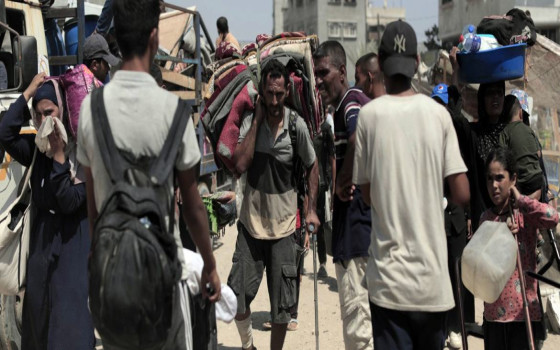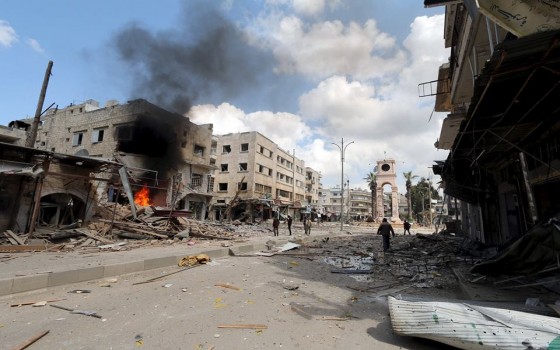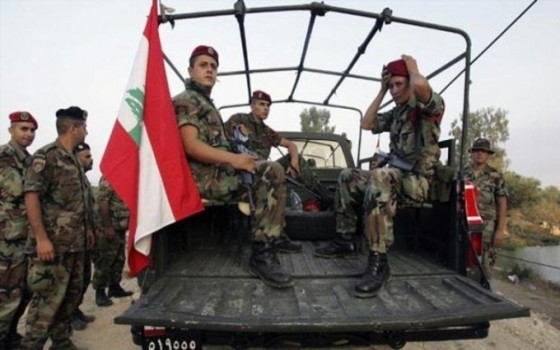
New Palestinian casualties on the 307th day of the Israeli aggression on Gaza.. Nearly 40 thousand dead and 92 thousand injured

- Europe and Arabs
- Thursday , 8 August 2024 7:44 AM GMT
Gaza: Europe and Arabs - Agencies
7 Palestinians were martyred and a number of others were injured as a result of the Israeli occupation's bombing of various areas in the Gaza Strip.
The Palestinian News Agency "Wafa" reported today, Thursday, that 5 Palestinians were martyred and others were injured as a result of the occupation's aircraft targeting a house in "Al-Sahaba" Street in Gaza City. It explained that another citizen was martyred as a result of the occupation's bombing of a house east of the "Block 4" area, Al-Madaris Street in Jabalia camp, north of the Gaza Strip.
It added that ambulance crews retrieved a martyr from a house on Jaffa Street in the Al-Tuffah area in Gaza City, and the occupation's warplanes also targeted Palestinian homes south of Al-Sabra neighborhood, the eastern areas of the city, and a house next to Majida Wasila School.
It indicated that the occupation's warplanes launched a raid on the town of Beit Lahia, north of the Gaza Strip, while fires broke out as a result of the occupation army's bombing with artillery and smoke shells on the eastern areas of Beit Lahia, and the city of Al-Asra, Al-Zahraa city, Al-Maghraqa area, and north of Al-Nuseirat camp in the central Gaza Strip were subjected to artillery shelling.
In Khan Yunis city, a Palestinian woman was killed in a house bombing with a missile from an Israeli drone in the town of Bani Suhaila, east of the city. A number of citizens were also injured in a house bombing in the center of the town of Abasan al-Kabira, east of Khan Yunis, while the occupation tanks opened heavy fire towards the east of the town of al-Qarara, east of the city.
An Israeli warplane targeted the upper floors of the Jibril Tower on al-Bi'ah Street in the city of Deir al-Balah in the central Gaza Strip with a missile. The planes also launched two raids on the northeastern area of Rafah city, south of the Gaza Strip.
The Israeli occupation forces have continued their land, sea and air aggression on the Gaza Strip for 307 days, as the death toll from the aggression has risen to 39,677 martyrs and 91,645 wounded.
This comes after the United Nations Office for the Coordination of Humanitarian Affairs reported that the ongoing hostilities and repeated evacuation orders are causing an endless cycle of displacement and making it increasingly difficult for people to obtain the humanitarian aid they need to survive, after 10 months of war.
As an example, the UN office explains that when malnourished children in Gaza are forced to flee suddenly, it is extremely difficult for humanitarian partners to monitor and follow up on the delivery of essential services, while displaced families find it difficult to carry supplies to prevent and treat malnutrition.
Repeated displacement – combined with insecurity, access restrictions and other challenges – also hinders the early identification of children and women in need of nutrition services. These factors also limit partners’ ability to expand their operational presence and stockpile life-saving supplies.
The UN office reaffirmed the commitment of the United Nations and its humanitarian partners in Gaza to provide vital assistance to people across the Strip wherever and whenever possible. Shelter response partners in Gaza continue to monitor the movement and needs of newly displaced people in Deir al-Balah and Khan Younis and provide the necessary support. Since 22 July, partners have provided hundreds of tents to displaced families in southern, central and northern Gaza. Meanwhile, 48 UN partners working on the health response in Gaza have reached over a quarter of a million people across the Strip since 22 July. There are also more than a dozen emergency medical teams supporting local health workers, including three in northern Gaza. However, OCHA says the ongoing hostilities and shelling have caused numerous incidents and mass casualties in recent weeks, straining the capacity of humanitarian organizations to respond to trauma and emergency situations. Poor water, sanitation and hygiene conditions – coupled with overcrowding – are also leading to disease outbreaks.












No Comments Found